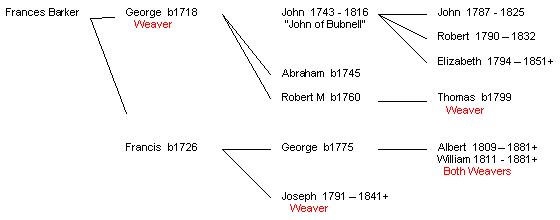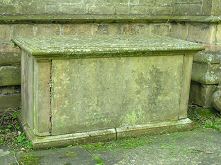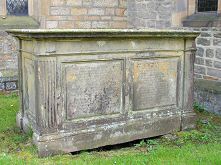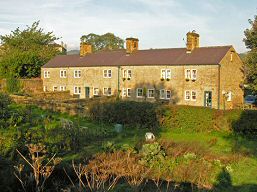The Barker Families and the Weaving TradeCompiled by David Dalrymple-Smith, © Copyright November 2006
This article outlines the Barker families in Baslow and Bubnell, provides evidence of weaving in the villages and comments on the absence of Retailers and Tradesmen in Bubnell. The Duke of Rutland was Lord of the Manor. In 1841 the population of Baslow (excluding Bubnell) was 877 and of Bubnell 214. There were three branches of Barker families. 1. The Baslow Barkers can be traced back to Henry Barke (sic) who had two children, Olive christened in 1639 and Robert in 1641. In the 1700s they were living at Baslow Bridge. There is no trace of them in the 1841 Census, though a John Barker (Glover 1829), Victualler at the Wheatsheaf Inn, could have been the member of the family. 2. The Bubnell Barkers
The first recorded Barker was Frances, whose son George was born in 1718. George and five of his relatives are recorded in Parish Records and Census Returns as Weavers. As the former only mention an occupation to distinguish two persons with the same name, it is likely that there were further Weavers in Bubnell in pre Victorian times. It confirms the local tradition of a history of Weaving in Bubnell.
“John of Bubnell” b. 1743 was a substantial figure in the Village. His tomb is the second largest in the church yard. His eldest son, John obtained a University Degree, enrolled in the Army and was killed in 1812 in the siege of Badajos (Spain, Peninsular War). His second son Robert was a “Gent, Farmer” (Glover 1829) and his daughter Elizabeth was an Annuitant in the 1841 Census. She lived in Bubnell House, had five domestic servants in 1841, and in the 1848 Tithe Award was the largest tenant farmer in Bubnell with 148 acres. There is no definite record that John of Bubnell was related to the other Bubnell Barkers, but he fits neatly into the family tree as eldest son of George (b. 1718) being only two years older than Abraham the oldest recorded son of George. It is likely that he inherited the tenancy of Bubnell House and farm from George, while his brothers continued the family tradition of weaving.
3. The Clerical Barkers. John Barker (b1761), who has the largest tomb in the Graveyard, was appointed Curate (variously described as Vicar and Perpetual Curate) in 1794. There is no suggestion that he was related to any of the resident Barkers. On his death in 1824 he was succeeded by his son Rev. Auriol Anthony Barker (b1759) who reigned until he died in 1853. His son Frederick (1828-1882) was Curate for a few months before he emigrated to Australia to take up his new post as Bishop of Sydney. Bubnell and the Weaving TradeAnalysis of the Census years 1841 to 1901 shows an extraordinary lack of Retail and Trade activity in Bubnell. The only shop, excluded two 70 year old men listed as Grocers, belonged to the Tomlinsons who were Butcher/Farmers in the farm adjacent to Baslow next to the bridge. The only other skilled workers were John Haskey a weaver in 1841 & 1851, John Littlewood a Joiner in 1841, and a handful of miners and quarrymen who must have worked elsewhere as there were no mines or quarries in the village at the time. The Tithe Award reveals no Freeholders in the hamlet. It is not likely that this arrangement was due to chance. I suggest that the Duke of Rutland wanted a “pure” village devoted entirely to farming. To this end he suppressed the development of shops and trade, actually moving the Weavers out into Baslow. In short Bubnell was the Duke of Rutland's “Model Village”. Information is mainly from Parish records, supplemented by data from the Censuses of 1841 and 1851, the Tithe Award of Bubnell and Churchyard memorial inscriptions. The above information was contributed by David Dalrymple-Smith in November 2006. |
||||||||||



